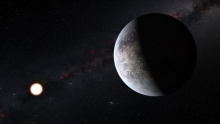This week Canada announced it will contribute to the European Space Agency’s Ariel mission. A first mission of its kind, the Ariel space telescope will launch in 2029 to study the atmospheres of distant exoplanets outside of our solar system. Up to 12 Canadian astronomers, including McGill University experts, will be at the front row of the mission, with privileged access to its data. (Canadian Space Agency)


XO-3b, a hot Jupiter on an eccentric orbit. Credit: NASA/JPL-Caltech/R. Hurt (IPAC)

Mini-Neptunes and super-Earths up to four times the size of our own are the most common exoplanets orbiting stars beyond our solar system. Until now, super-Earths were thought to be the rocky cores of mini-Neptunes whose gassy atmospheres were blown away. In a new study published in The Astrophysical Journal, astronomers from McGill University show that some of these exoplanets never had gaseous atmospheres to begin with, shedding new light on their mysterious origins.

Two McGill University astronomers have assembled a “fingerprint” for Earth, which could be used to identify a planet beyond our Solar System capable of supporting life.

A new study by McGill University astronomers has found that the temperature on the nightsides of different hot Jupiters is surprisingly uniform, suggesting the dark side of these massive gaseous planets have clouds made of minerals and rocks.
Using data from the Spitzer Space and the Hubble Space telescopes, the researchers from the McGill Space Institute found that the nightside temperature of 12 hot Jupiters they studied was about 800°C.

It’s been an exciting time for astronomy lovers in the past few years: the first black hole picture amazed, many exoplanets have been discovered, gravitational waves were observed for the first time.
Now, what will be the next big things in astronomy?
Astronomers from across Canada will gather in Montreal June 17-20 to discuss emerging topics that could lead to big new advances in the field in the coming decade.

A sample of ancient oxygen, teased out of a 1.4 billion-year-old evaporative lake deposit in Ontario, provides fresh evidence of what the Earth’s atmosphere and biosphere were like during the interval leading up to the emergence of animal life.
More than 90% of Earth’s continental crust is made up of silica-rich minerals, such as feldspar and quartz. But where did this silica-enriched material come from? And could it provide a clue in the search for life on other planets?
